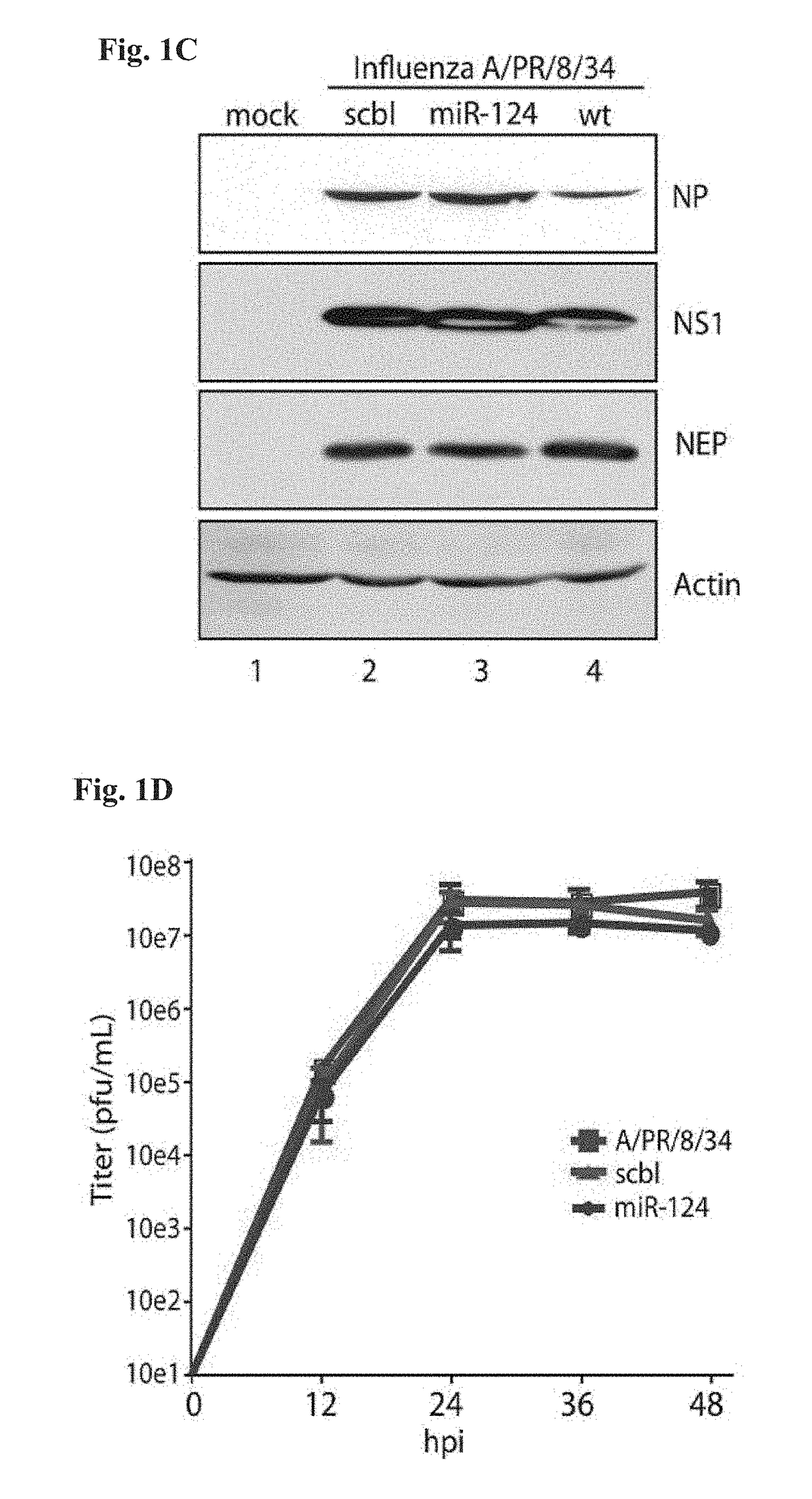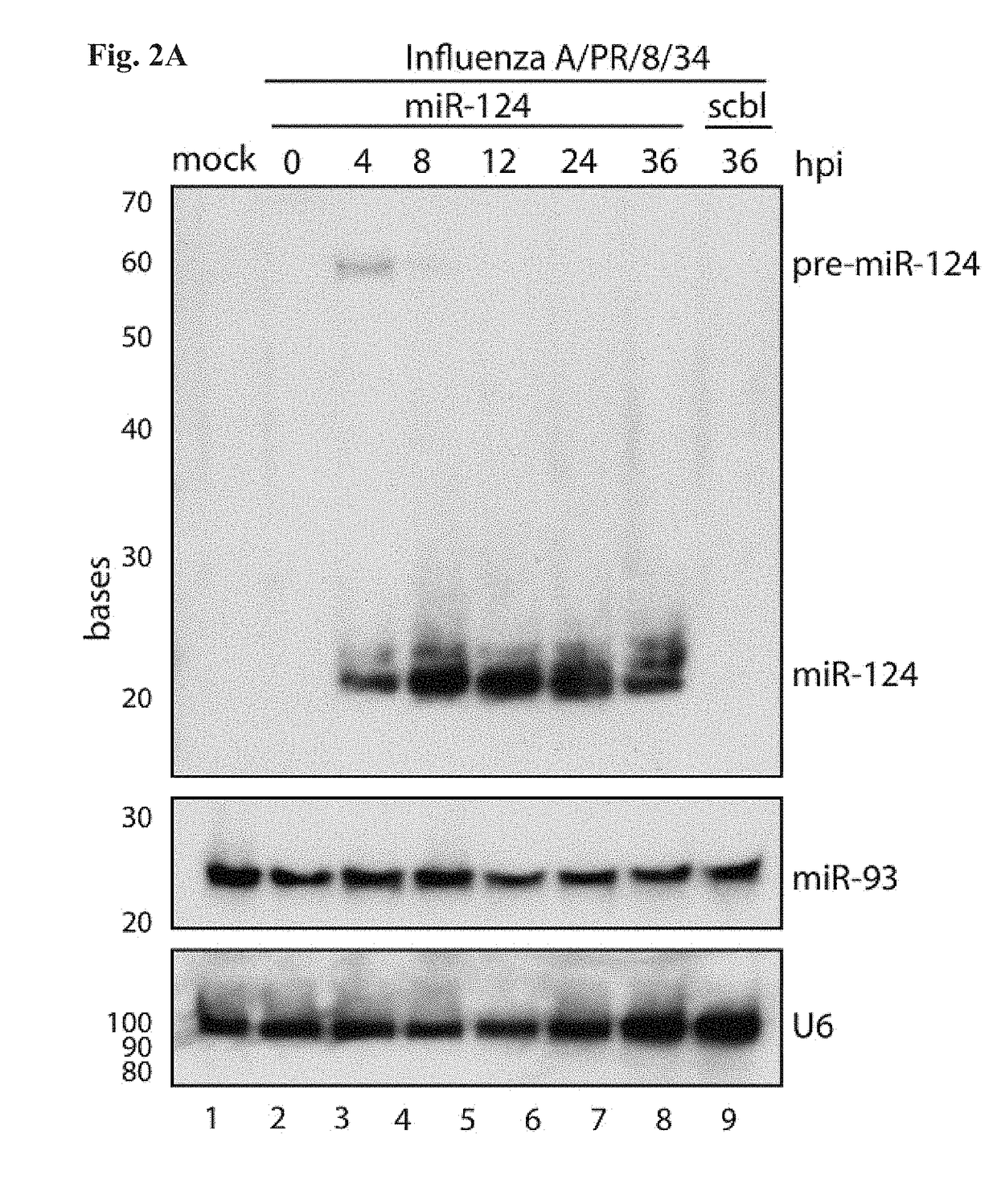Recombinant RNA Viruses and Uses Thereof
a technology of rna viruses and rna, which is applied in the field of recombinant rna viruses, can solve the problems of limited application of genomic integration and/or insufficient generation of intracellular mirnas, and achieve the effect of enhancing the host immune response to vaccination
- Summary
- Abstract
- Description
- Claims
- Application Information
AI Technical Summary
Benefits of technology
Problems solved by technology
Method used
Image
Examples
example 1
6.1 Example 1
[0402]This example demonstrates that influenza virus can be engineered to produce functional miRNA without loss of viral growth.
6.1.1 Materials and Methods
[0403]6.1.1.1 Cell Culture
[0404]HEK293, MDCK, CAD, and murine fibroblasts were cultured in DMEM (Mediatech) media supplemented with 10% Fetal Bovine Serum and 1% penicillin / streptomycin. Dicer deficient fibroblasts were provided by A. Tarakhovsky (Rockefeller University, NYC) and Donal O'Carrol (EMBL, Monterotondo) and CAD cells were provided by T. Maniatis (Columbia University, NYC).
[0405]6.1.1.2 Virus Design and Rescue
[0406]The modified NS segment (A / PR / 8 / 34) was generated by PCR, followed by a three-way ligation. The splice acceptor site in the NS1 ORF (521 5′tcttccaggacat3′ 533) was mutated to prevent splicing (521 5′tctCccGggacat3′ 533) of NS mRNA at this site by site-directed mutagenesis using the primers 5′-CCATTGCCTTCTCTCCCGGGACATACTGCTGAGGATGTC-3′ (SEQ ID NO:5) and 5′-GACATCCTCAGCAGTATGTCCCGGGAGAGAAGGCAATGG-3...
example 2
6.2 Example 2
[0431]This example demonstrates that Sindbis virus, a positive single stranded cytoplasmic virus, can be engineered to produce functional miRNA.
[0432]The mmu-pri-miR-124-2 locus (chr3:17,695,454-17,696,037) was inserted into a a unique BstEII restriction site downstream of the structural genes of Sindbis virus (Strain s51) and included a duplicate subgenomic promoter (FIG. 7A). The recombinant strain (Sindbis-124) is able to infect CAD cells (FIG. 7B) and produces both pre-miR-124 and miR-124 in human fibroblasts from 4 through 36 hours post infection at an MOI of 1.0 (FIG. 7C).
[0433]6.2.1 Sindbis-Produced miR-124 Requires Dicer but is Exportin-5 Independent
[0434]Exportin-5-positive 293 fibroblasts, exportin-5-negative 293 fibroblasts, dicer-positve immortalized murine fibroblasts, and dicer-negative immortalized murine fibroblasts were infected with a mock control, Sindbis-124, or Sindbis virus (Strain s51) encoding a scrambled (scbl) RNA locus, and the ability of the ...
example 3
6.3 Example 3
[0435]MicroRNA can be generated that targets a gene of interest using model miRNA. To generate such artificial miRNA that targets a gene of interest from model RNA, certain parameters can be followed, such as (i) the overall predicted structure of the model miRNA can be conserved in the artificial miRNA; (ii) the artificial miRNA can contain the 5′ and 3′ flanking sequences of the model pre-miRNA; (iii) the buldge of the hairpin can be identical between the artificial and model miRNAs; and (iv) the complementarity along the stem of the artificial miRNA can match that of the model miRNA.
[0436]6.3.1 Human NFκBIA Gene
[0437]To target the human NFκBIA gene (accession number NG 007571.1; GENE ID NO: 4792), a heterologous RNA can be designed, modeled after miR-30a (GENE ID NO: 407029), as shown in FIG. 10A.
[0438]6.3.2 Influenza Virus Nucleoprotein Gene
[0439]To target an influenza virus nucleoprotein gene (accession number EF190975.1), a heterologous RNA can be designed, modele...
PUM
| Property | Measurement | Unit |
|---|---|---|
| temperatures | aaaaa | aaaaa |
| time | aaaaa | aaaaa |
| time | aaaaa | aaaaa |
Abstract
Description
Claims
Application Information
 Login to View More
Login to View More - R&D
- Intellectual Property
- Life Sciences
- Materials
- Tech Scout
- Unparalleled Data Quality
- Higher Quality Content
- 60% Fewer Hallucinations
Browse by: Latest US Patents, China's latest patents, Technical Efficacy Thesaurus, Application Domain, Technology Topic, Popular Technical Reports.
© 2025 PatSnap. All rights reserved.Legal|Privacy policy|Modern Slavery Act Transparency Statement|Sitemap|About US| Contact US: help@patsnap.com



